How We Do SEO (Search Engine Optimization)
Since I’ve explained this about a bazillion times, and I’m getting sick of the sound of my own voice, I decided to write up this summary of WebSauce’s initial approach to a new SEO project.
First Step
Before engaging in any “optimization” at all, the first steps are to:
1. Pick meaningful keywords/phrases
2. See how you rank on them
3. See how your competitors rank on them
4. See whether your competitors are ranking on keywords/phrases that we didn't include step 1.
We do not, and will not, take a job based on someone coming to us and saying “I must be #1 in Google for your favorite keyword here.”
Ain’t gonna do it and here’s an illustration of why…
Many years ago we had a client that insisted that they rank #1 for the key word “Lead” and the phrase “Lead Paint.” They were a small lead remediation and mold abatement contractor. Let’s see why trying to rank on “Lead” is such a bad idea:
Google ‘lead’
About 1,330,000,000 results (0.40 seconds)
In a universe of 1.3 billion results, the chances of getting a number one ranking for a 10 page brochure site for a small contractor is approximately 10 in 1.3 billion. Really, do the math! For contrast, the chance of winning PowerBall Grand Prize is, according to the PowerBall Web Site 1 in 175,223,510.
In addition, there are many meanings of lead as in to lead a horse, sales lead, and so on.
Conclusion: attempting to rank well on “Lead” is a really bad idea.
Let’s try “lead paint”:
Google ‘lead paint’
About 17,800,000 results (0.43 seconds)
That’s better (by quite a bit), but, again, do the math. To dig a little deeper on this this particular search, try this:
Google lead paint site:epa.gov
About 20,300 results (0.28 seconds)
So…think about it… The EPA site has 20,300 pages that rank for the phrase “lead paint.” Do you really think Google’s going to put your 10 page site, which isn’t even necessarily all about lead paint, ahead of a site that contains 20,300 pages that match the phrase “lead paint”?!?
We were able to get them to use narrower search terms like “lead paint removal townname”, where “townname” was the name of one of the surrounding towns (their geographic targeting area) and get them number one rankings for every single one of those. Easy peasy since Google sees that the 20,300 EPA pages don’t have doodly to do with “townname” and our client’s site (very intentionally), does.
SEO Arrows
The analogy I use to describe our method of SEO involves a quiver of arrows…
We have a large number of possible techniques for moving our client sites up in ranking on the various search engines. I refer to each of those as an arrow.
When most SEO firms approach a new job, they are ready to pull out all the stops and fire every arrow in the quiver at the site. While this generates lots of revenue for the SEO firm, is a very impressive amount of apparent motion, and can produce OK to good results, it’s wrong. It’s a wrongheaded application of SEO techniques, and, more importantly, it’s a huge waste of the client’s money.
Our approach is different.
I only take one arrow out at a time and I start with the one most likely to produce the result we want with as little work as possible. Not lazy, just efficient.
First Arrow
The first arrow out of our quiver, in almost all cases, is the Validation Arrow. As I’ve written in another post, if your web site’s HTML and CSS are not up to standards, there’s no guarantee that your content is even being seen by the search engine’s spiders. Spiders are the programs that go and try to read the content on your site so that they can be put into the search engine’s results.
While spiders have gotten progressively better at reading bad web sites, they’re still not perfect and never will be as there is an infinite number of wrong ways to create a web page.
Fortunately, there is one verifiably right way and that way is to make the page’s HTML and CSS conform to the W3C standards. The W3C is the World Wide Web Consortium which is the organization in charge of web standards.
The World Wide Web Consortium (W3C) is an international community where Member organizations, a full-time staff, and the public work together to develop Web standards. Led by Web inventor Tim Berners-Lee and CEO Jeffrey Jaffe, W3C’s mission is to lead the Web to its full potential.
By running the W3C validator on the pages of your site, and correcting any errors reported by that tool, you are virtually guaranteed that the search engine spiders will see all of the content on your site.
Unfortunately, it’s a huge pain in the neck to run the tool on every page on your site.
The WebSauce SEO Toolkit contains a tool that will validate your entire site in one shot. From this, the program gives us a simple TODO list of what needs to be done to make your site 100% valid HTML. Since we do this all the time, this is usually a pretty inexpensive option and will get your site ranking on its actual content.
Also part of the WebSauce SEO Toolkit is the one-button link checker. This will ensure that all of the links on your site actually go somewhere (and not to a 404 page, for example). We also make sure that all of your images are present and reasonable sizes, and that your pages load reasonably quickly (slow page loads hurt ranking). We have tools that measure many other things, but remember, this is only one arrow…
When the whole site is valid, links are all good, and page load speeds appropriate, we submit a site map to make sure Google sees and properly indexes all of the pages on your site.
Then, we do something considered heretical by the rest of the SEO world: we stop billing the client for apparent motion and wait.
Yup. We Wait.
As Dear Old Dad used to say, we don’t “jump on our horse and ride off in all directions at once.” We wait.
Since the search engines contain a chunk of content from your pages in the search result listing, we just wait until a recognizable chunk of one of your newly valid pages shows up. That way we know that the site has been properly indexed.
We then see how your pages are ranking and, if we’re not where we want to be, we can pull out another arrow IF NEEDED.
Often times and in fact in most cases, that one arrow is enough to bring your site up in the rankings substantially, assuming it’s actually relevant the keywords on which you want to be found.

